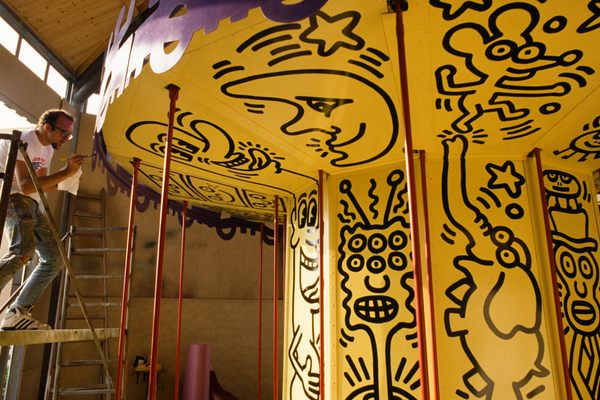11 Lost Wonders of 2013
Vintage view of the Pan Am Worldport (via Save the Worldport)
As we gear up for another year of discovering the wonders of the world, we look back at some extraordinary places we lost in 2013. From a utopian rooftop villa in Beijing to striking Brutalist buildings, here are 11 destinations that met their demise.
HIGGINS ARMORY MUSEUM
Worcester, Massachusetts
via Massachusetts Office of Travel & Tourism
The Higgins Armory Museum in Worcester, Massachusetts had a collection of arms and armor second only in the United States to the Metropolitan Museum. The museum had its final open day on December 31 and its shields, helmets, swords, and other warrior accouterments are being relocated to the Worcester Art Museum where a gallery opening in 2015 will be devoted to the collection. As for its fortress-like former home — believed by many to be the first American glass and steel structure — its future still remains uncertain.
BROKEN ANGEL
Brooklyn, New York
Broken Angel eviction party (photograph by Allison Meier/Atlas Obscura)
This March, after having its towering structures diminished, a fire, and other woes, the vernacular architecture marvel the Broken Angel had its eviction party in Brooklyn. Over three decades, the Clinton Hill home had been transformed into a stunning construction of towers, mosaics, and embedded art, and while it’s sad to see it go, at least it got a celebratory send off.
WONDERLAND
Beijing, China
photograph by Zoetica Ebb, Alternative Beijing
What was once meant to be a theme park on par with Disneyland on the outskirts of Beijing was abandoned before it was completed. However, the castle that did get built and the other whimsical structures of Wonderland were later surrounded by cornfields in an otherworldly scene. Sadly, this April most of these buildings were torn down, although reports say that the castle still stands.
PAN AM WORLDPORT
New York, New York
photograph by Glenn Beltz/Flickr user
One of the survivors of the mid-century golden age for airports, the UFO-like Pan Am Worldport met its demise this fall as it was torn down to make way for an airplane parking lot at JFK Airport. It had turned into a Delta terminal in recent years after its original operator Pan Am left, but even then it retained its unique character. However, you can still find some of its glory days remembered at the site of Save the Worldport, which tried to the end to preserve the vestige of aviation history.
CYCLORAMA
Gettysburg, Pennsylvania
photograph by lcm1863/Flickr user
The strikingly modernist Cyclorama building — which was once home to a circular painting of the Battle of Gettysburg — was demolished in March. As we wrote in our own eulogy, “Civil War buffs felt victorious, but architecture fans mourned,” as the wreckers cleared the battlefield of the controversial building. However, lovers of the Brutalist design by Richard Neutra mourned the demolition of the concrete cylindrical building.
PRENTICE HOSPITAL
Chicago, Illinois
photograph by htomren/Flickr user
The downtown Chicago hospital was another cylindrical Brutalist building on the chopping block demolished this fall. Using early computer modeling, the 1970s Prentice Hospital designed by Bertrand Goldberg was the only building of its kind in the world. While made of concrete, the cloverleaf building seemed to soar with a smooth shape that contrasted to the right angles all around it.
HOFFMAN SHOWROOM
New York, New York
photograph by Ezra Stoller, via steinerag.com
Maybe it was just a bad year for circular building. The Frank Lloyd Wright-designed Hoffman Showroom (later used by Mercedes) on Park Avenue in Manhattan was suddenly torn down this April before preservationists could intercede. It seems shocking that a Wright building could disappear so quickly, especially with a sloping curved interior design not dissimilar from his Guggenheim Museum, but no matter the fame of an architect there can still be these staggering losses.
ROOFTOP VILLA
Beijing, China
A rocky villa complete with draped plants and spindly trees was built by a professor on top of a 26-story Beijing apartment building. Alas, the dream of a private hanging garden was dashed as there was an official government order last year to demolish it. In December that decision was executed and the little manmade mountain above the city was destroyed.
CLOCKTOWER GALLERY
New York, New York
photograph by Allison Meier/Atlas Obscura
The experimental Clocktower Gallery art space up on the top floor of the 1890s McKim, Mead & White building in Lower Manhattan closed this November, where rooms were regularly taken over by immersive installations or strange performances. Luckily, for now, despite the building being sold by the city and condos likely moving in, the stunning clock itself is still operating. Each Wednesday it gets wound for another eight-day cycle, and hopefully will continue to be ticking well into the future.
HEIDELBERG PROJECT
Detroit, Michigan
photograph by E-ren Chow
The Heidelberg Project in Detroit is still an ongoing series of art houses, but unfortunately the number of these architectural wonders was greatly diminished last year. Four of its seven homes were destroyed by arson. Additionally, taxes and foreclosures threaten the future of the little colony of colorful buildings, which some see as remedying blight, and others see as an eyesore.
5 POINTZ
Long Island City, New York
Tags on a whitewashed 5 Pointz (photograph by Steven Severinghaus)
5 Pointz was a legal place for street artists and taggers to collaborate in Long Island City. The massive warehouse covered with murals was one of the most iconic buildings in New York City. However, prior to its imminent demolition, the building was whitewashed by its developers and will soon disappear entirely for new glassy apartments.










Follow us on Twitter to get the latest on the world's hidden wonders.
Like us on Facebook to get the latest on the world's hidden wonders.
Follow us on Twitter Like us on Facebook